|
5 August 2000 Puerto
La Cruz, Venezuela (10.12N; 64.39W)
Our big adventure to Angel Falls has come and gone. It's hard to imagine
that it all took place in just 2 1/2 days. Getting there was something
of a travel triathalon. Our guide Rangel collected us from Bahia Redonda
Marina in the dark at 0500 in a Ford Fairlaine taxi of late 60s vintage.
The three-hour ride from Puerto La Cruz to Ciudad Bolívar was on a fairly
straight, fairly level, fairly good, mostly two-lane highway on which
our taxi zoomed at least 70mph, passing constantly. Venezuelan drivers
use that same make-a-third-lane-out-of-the-middle system as the Trinis.
I asked Don, "How fast are we going, or is this like the Trinidad taxis
with the speedometer disconnected?" He peered forward and replied, "There's
no speedometer!" Or any other gauges, …just empty black holes!!
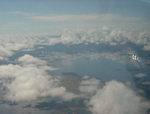 In
Ciudad Bolívar we changed to an airplane - a 6-place Cessna 210 with retractable
gear. Now this part was fun! While Don explained all the functions of
the instruments, etc. (he was most entertained by the Garmin C-map GPS
the pilot was using), I was entranced by the landscape below as we flew
south. Civilization peters out pretty quickly. Low rolling hills rise
from the savannah and except for scattered mining operations (diamonds,
steel, bauxite) and their associated towns, there is little sign of man.
Next unfolded the country's second largest lake, man-made about 100 miles
long 54 miles wide with hundreds of hilltop (and treetop!) islands poking
up! The first sign of the tepuys was a ridgeline rising in a fat wedge
out of the hills, with a sheer drop on the other side. From this rise
the tepuys themselves, table-top mountains, bluff and square, the way
I imagine Arizona is, only this land is mostly green. Then there are tepuys
upon tepuys, their craggy and jagged rims making startling canyons. In
Ciudad Bolívar we changed to an airplane - a 6-place Cessna 210 with retractable
gear. Now this part was fun! While Don explained all the functions of
the instruments, etc. (he was most entertained by the Garmin C-map GPS
the pilot was using), I was entranced by the landscape below as we flew
south. Civilization peters out pretty quickly. Low rolling hills rise
from the savannah and except for scattered mining operations (diamonds,
steel, bauxite) and their associated towns, there is little sign of man.
Next unfolded the country's second largest lake, man-made about 100 miles
long 54 miles wide with hundreds of hilltop (and treetop!) islands poking
up! The first sign of the tepuys was a ridgeline rising in a fat wedge
out of the hills, with a sheer drop on the other side. From this rise
the tepuys themselves, table-top mountains, bluff and square, the way
I imagine Arizona is, only this land is mostly green. Then there are tepuys
upon tepuys, their craggy and jagged rims making startling canyons.
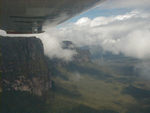 Rangel,
our guide, was himself a former bush pilot, and he and our pilot were
old buddies. We assume because of this old friendship...and perhaps a
little showing off for the American pilot in the backseat...we made three
loop-de-loop fly-bys in the dramatic Ayantepui canyon, actually below
the tops of the cliffs, trying to get a good look at the falls from the
air. (Angels Falls is named for the American bush pilot Jimmy Angel who
crash-landed his plane on the top of Ayantepui in his effort to document
it. His plane was "recovered" and sits in front of the Ciudad Bolívar
Airport.) Although the day was mostly fair, a stubborn cloud persisted
in shrouding the upper two-thirds of the falls itself. Many people make
only the air trip to Angel Falls (there were other planes lining up to
make the pass even as we looped around!); our experience just proved that
you could pay your $$ but still be disappointed. Fortunately, we were
destined for better things. Rangel,
our guide, was himself a former bush pilot, and he and our pilot were
old buddies. We assume because of this old friendship...and perhaps a
little showing off for the American pilot in the backseat...we made three
loop-de-loop fly-bys in the dramatic Ayantepui canyon, actually below
the tops of the cliffs, trying to get a good look at the falls from the
air. (Angels Falls is named for the American bush pilot Jimmy Angel who
crash-landed his plane on the top of Ayantepui in his effort to document
it. His plane was "recovered" and sits in front of the Ciudad Bolívar
Airport.) Although the day was mostly fair, a stubborn cloud persisted
in shrouding the upper two-thirds of the falls itself. Many people make
only the air trip to Angel Falls (there were other planes lining up to
make the pass even as we looped around!); our experience just proved that
you could pay your $$ but still be disappointed. Fortunately, we were
destined for better things.
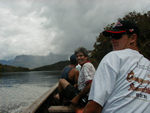 Landing
at Canaima Falls, a base-camp Indian village dedicated to this particular
tourist industry, we transferred to dugout canoe for the trip upriver.
We had a captain, his wife/mate and a bowman (all three Pémon Indians)
for the three of us plus Rangel. Normally this 36'-long (4' beam) craft,
powered by a 50hp Yamaha, might carry 8-10 passengers! Not only was our
group small, but tourist traffic on the river was way down, due, we were
told, to the uncertainties surrounding the Presidential elections the
day before. This gave us the vivid illusion of being solitary adventurers. Landing
at Canaima Falls, a base-camp Indian village dedicated to this particular
tourist industry, we transferred to dugout canoe for the trip upriver.
We had a captain, his wife/mate and a bowman (all three Pémon Indians)
for the three of us plus Rangel. Normally this 36'-long (4' beam) craft,
powered by a 50hp Yamaha, might carry 8-10 passengers! Not only was our
group small, but tourist traffic on the river was way down, due, we were
told, to the uncertainties surrounding the Presidential elections the
day before. This gave us the vivid illusion of being solitary adventurers.
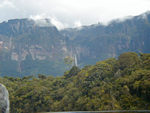 The
four-hour trip upriver (hard plank seats, no seat backs!) wound through
incredible scenery, turn after turn. The river was high, its water flooding
well into the trees lining the banks. The tepuys rise as high as 2500
meters in straight cliff sides, each like some sort of layered trifle:
a layer for trees, a layer of red rock, a layer of yellow rock, and a
top layer of fractured rim through which leak dozens and dozens of waterfalls. The
four-hour trip upriver (hard plank seats, no seat backs!) wound through
incredible scenery, turn after turn. The river was high, its water flooding
well into the trees lining the banks. The tepuys rise as high as 2500
meters in straight cliff sides, each like some sort of layered trifle:
a layer for trees, a layer of red rock, a layer of yellow rock, and a
top layer of fractured rim through which leak dozens and dozens of waterfalls.
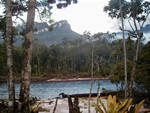 The
farther upriver we went, the more frequent became sections of rapids.
It also got sharply cooler, and just before out arrival at the camp near
dusk we got caught by a swirl of rain and mist just as we had to negotiate
giant boulders in the roiling water! Pretty exciting stuff. By the way,
the water is the color of Cherry Coke syrup, right from the falls on down!
The rivers we were on empty eventually into the Orinoco, which empties
eventually into Paria Sound. No wonder Trinidad's water is the color it
is! The
farther upriver we went, the more frequent became sections of rapids.
It also got sharply cooler, and just before out arrival at the camp near
dusk we got caught by a swirl of rain and mist just as we had to negotiate
giant boulders in the roiling water! Pretty exciting stuff. By the way,
the water is the color of Cherry Coke syrup, right from the falls on down!
The rivers we were on empty eventually into the Orinoco, which empties
eventually into Paria Sound. No wonder Trinidad's water is the color it
is!
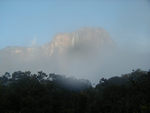 Rangel
hustled us up at 0530, and we were fed, clothed and on the trail before
0630! The hike itself was moderately easy, the biggest challenge being
the network of tree roots threading the path. This is primary growth rainforest!
Never been cut! We admit, the big Trinidad hiking duo was not quite in
the shape we'd been before a month of floating sloth so that keeping up
with Rangel who moved like a gazelle with a fire on his butt was a bit
of a struggle. His goal, of course, was to get us up there before the
clouds rolled in, ...and it was worth it! Rangel
hustled us up at 0530, and we were fed, clothed and on the trail before
0630! The hike itself was moderately easy, the biggest challenge being
the network of tree roots threading the path. This is primary growth rainforest!
Never been cut! We admit, the big Trinidad hiking duo was not quite in
the shape we'd been before a month of floating sloth so that keeping up
with Rangel who moved like a gazelle with a fire on his butt was a bit
of a struggle. His goal, of course, was to get us up there before the
clouds rolled in, ...and it was worth it!
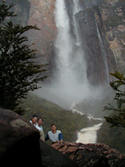 Angel
Falls makes a nearly 1000 meter drop! About six streams burst from the
crevices at the top of Auyantepui, one or two dropping into midway pools,
the others free falling the whole way. The mist, the wind, the roar are
awesome. We actually clambered down to the pool at the base, where ,to
our amazement, Rangel went swimming! (Air and water were both pretty chilly!)
"It is a superstition," he says. (Rangel leans toward the poetic.) At
his urging we each edged out through the bracing roil (behind some rocks
just at the top of the next furious drop..."don't worry, it's perfectly
safe…, but only if you want to.") in order to experience the pure full-length
view of the falls. Let me tell you, you don't get the same effect from
the airplane! (Nor do you get digital photos!) Back at the base of the
trail we encountered another group of about sixteen German tourists, just
starting up. They and their guides were astounded that we had already
come and gone. We gave profound thanks after we'd passed them for Rangel's
determined timing. It just wouldn't have been the same with a crowd. Angel
Falls makes a nearly 1000 meter drop! About six streams burst from the
crevices at the top of Auyantepui, one or two dropping into midway pools,
the others free falling the whole way. The mist, the wind, the roar are
awesome. We actually clambered down to the pool at the base, where ,to
our amazement, Rangel went swimming! (Air and water were both pretty chilly!)
"It is a superstition," he says. (Rangel leans toward the poetic.) At
his urging we each edged out through the bracing roil (behind some rocks
just at the top of the next furious drop..."don't worry, it's perfectly
safe…, but only if you want to.") in order to experience the pure full-length
view of the falls. Let me tell you, you don't get the same effect from
the airplane! (Nor do you get digital photos!) Back at the base of the
trail we encountered another group of about sixteen German tourists, just
starting up. They and their guides were astounded that we had already
come and gone. We gave profound thanks after we'd passed them for Rangel's
determined timing. It just wouldn't have been the same with a crowd.
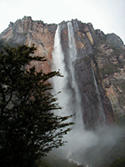 At
the camp our Indian crew had roasted a whole flock of chickens over an
open fire, which meant we sorely overate before our downstream canoe trip,
which, thankfully, took about half the time as the upstream trip had taken.
We got a shower and change of clothes at the base camp, hustled back onto
our plane, and in no time found ourselves back in the hot steamy urbanity
of Ciudad Bolívar. At
the camp our Indian crew had roasted a whole flock of chickens over an
open fire, which meant we sorely overate before our downstream canoe trip,
which, thankfully, took about half the time as the upstream trip had taken.
We got a shower and change of clothes at the base camp, hustled back onto
our plane, and in no time found ourselves back in the hot steamy urbanity
of Ciudad Bolívar.
We probably could have come directly home as well as not, but Rangel takes
doling out tourism seriously and he felt we should see something of this
historic city on the Orinoco. Looking back on such things, I am usually
glad of the historical tidbits I absorb from these tours, but at the time
we were skeptical. Our hotel, overlooking the Orinoco plus a Times-Squarish
whirl of noisy hustle-bustle, was a doubtful facility, which we only came
to appreciate after seeing some of the options. We did manage to get the
AC working and to find some ice, and we all collapsed for a delicious
nap on an acceptably comfortable (flat!) bed. Rangel practically had to
force us out for dinner. Surprisingly we learned that Venezuelans normally
eat quite early, and restaurants were closing around 8pm.
Although we slept well, I awoke feeling...off. But Rangel hustled us forth
(this time we were late) for a traditional Venezuelan breakfast of cantaloupe,
fried catfish, fried plantains with cheese, salad (!) and fresh-squeezed
orange juice. Coffee comes in medicine-sized plastic Dixie cups, and they
had to make a special pot so that Don could have it without sugar! As
for me, Venezuelan cafe con léche (frothy steamed milk) suits me just
fine! From breakfast we strolled the local fisherman's market, then bussed
to the "old city", which was built on a big rock outcrop. Most of the
old buildings lining the street surrounding the square are now restored
and open for public viewing. An official function honoring an anniversary
of the Guarda National was getting underway, and military types were everywhere
including the very beautiful cathedral. The Spanish churches we've seen
so far are light and airy inside and colorful outside. In the cathedral
was a glorious nave of what looked like gold-leafed woven palms and the
choir was in full voice. On the outside, however, was a plaque commemorating
the execution site of another of Bolívar's "beloved" generals, General
Píar, who, when ordered to retreat to the other side of the Orinoco to
escape slaughter by the Spanish, instead stayed and wrested a spectacular
victory. He was tried and executed for disobeying orders.
At this point my malaise asserted itself, and we hustled back to the hotel.
Missing the air-conditioned bus back to Puerto La Cruz, we piled again
into an antiquated land yacht (this time a Chevrolet Caprice Classic (maybe
early 70s)) with no window handles, changing into a different one halfway
home. Evidently Chevrolet sold a lot of cars here, and here, where gas
is about 20 cents a gallon, is the only place they could live on this
way. These "fast taxis" line up at the bus stations and do the same routes.
Each three-hour trip cost Rangel a mere $50. Our final Chevrolet classic
had electric windows (that worked!) and a speedometer. At one glimpse
it showed 140 kilometers/hour!
We stopped looking. Upon arrival home I went down for the count for two
days. Don and Adam sipped cold Polars around the pool and dined out at
the newly reopened marina restaurant. Adam flew out Friday morning. I
came back to life late that afternoon, and now, guess who's out flat in
the aft cabin? Guess it was a flu bug and not the tourista.
Puerto La Cruz, oft mentioned in the same voice as Trinidad as a hurricane
haul-out facility, doesn't come close in our book. It would be inexpensive
and adequate for haul out, painting or marina storage, but basic parts
are hard to scare up, the language is a struggle, and the anxiety about
personal safely not endearing. I'm sure we haven't given it a fair shake,
but we hope to be out of here ASAP -- Monday or Tuesday, depending in
part on Don's recovery time.
BTW--Anyone interested in doing Angel Falls or any of a number
of such trips in Venezuela with our guide Rangel Zabala can contact him
by email at ecoaventura33@hotmail.com, telephone (014) 395.44.51 or fax
095-642529. Rangel intends to make his business catering to cruisers and
their friends.
BTW #2-Any
cruisers considering coming this way should purchase Kathy Parson's Spanish
for Cruisers: Boat Repairs and Maintenance Phrase Book. It is much more
than that. It's a mini-Spanish course (or refresher). But most of those
all-important those "boat-words" don't even appear in regular dictionaries.
You can order Spanish for Cruisers from Amazon.com (see my review there!).
continue
|